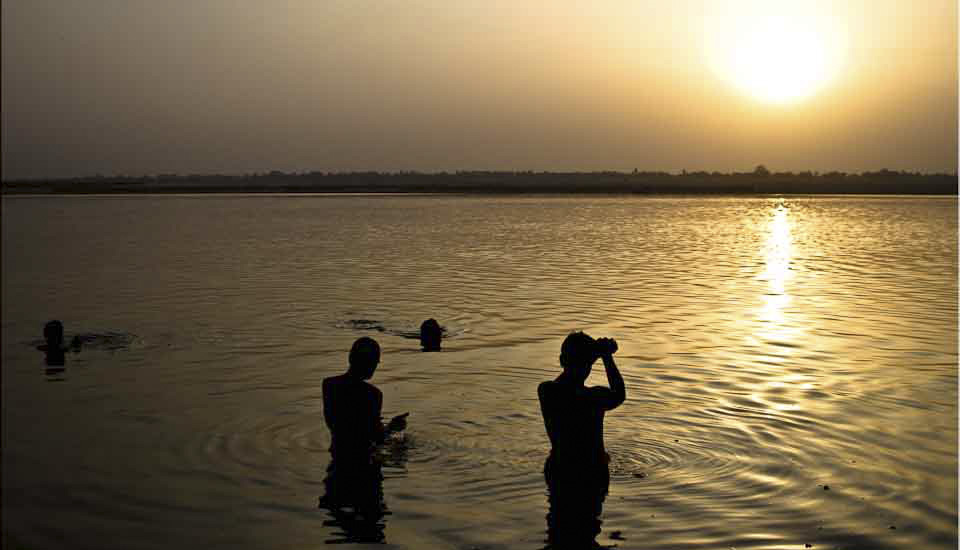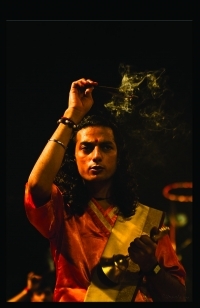.jpg)
Preparing to be “Pacha”
It takes a long time to get into character for a traditional Kathakali performance. At the Great K V Kathakali Center in Fort Kochi, Kerala, much of the preparation takes place on stage, so visitors can watch some of the complex process.
It was hot. And dark. And chaotically noisy.
And, I loved every minute of it!
To a non-Indian, a Kathakali dance performance can best be described as a Punch and Judy show on steroids.
One of India’s many forms of regional classical dance, Kathakali is unique to Kerala on India’s southwestern Malabar Coast. After spending a magically quiet time on the Kerala Backwaters with a small group, experiencing the evening Kathakali performance in Fort Kochi was a complete contrast!
The name comes from the Malayalam words katha (കഥ), meaning a story, conversation, or traditional tale, and kaḷi (കളി) meaning a performance or play. As with other Indian dance forms, the story-telling dance-drama involves complex stylised movements and hand gestures, as well as intricate eye- and facial-expressions, all of which take years to master.
Kathakali performances developed out of temple and folk arts, and date back to early Hindu texts. With traditional themes from folk stories, religious legends, and the Hindu epics, the narratives all centre around the eternal fight between good and evil.
Traditionally, the shows started at dusk and continued through until dawn, or even ran over several nights, starting at dusk each day. Modern productions are shorter: the one I attended at the Great K V Kathakali Center in Fort Kochi, Kerala, was a one-hour introductory performance, aimed at visitors. Before the actual show – from about 5pm – the artists applied their own and each other’s makeup on stage, so you could watch some of the lengthy and exacting process involved in getting ready. Then, a narrator/host had one of the performers demonstrate the eye, face, hand and body movements intended to convey specific meanings – all to a cacophony of cymbals and drums.
On this particular night, the performance itself was “Kiratham”: a popular piece written by Irattakkulangara Rama Warrier, who is believed to have lived in the first half of the 18th century. Broadly, it involves a fight between Arjunan (Arjuna), a prince and expert archer, and the Lord Shiva, one of the principal Gods of the Universe. Other characters include Parvathi, Shiva’s consort/wife; and King Duryodhana and his emissary Mookasura, who has taken the form of a wild boar. Shiva disguises himself as a forest-dwelling hunter, the boar is killed, fights ensue, arrows turn into flowers, and a bow is destroyed. It is all very noisy and confusing, but in the end, everyone is forgiven and lives happily …
So, never mind the story – come meet the performers:
.jpg)
The Theatre
Seating in the two-story Great K.V Kathakali Center theatre is assigned, but I took the opportunity to wander around before the actual performance.
.jpg)
Concentration
On the stage, the performers – traditionally all males – get into their stylised makeup.

Green Paint
Pacha (green) characters are usually pious, gentle, and noble. This face will eventually become Parvathi, Shiva’s consort.

Paste and Paint
The Chutti worn by some characters is a white raised structure around the jawline to enhance facial contours and reflect low lighting. They were originally made from rice powder paste, but are now built from paper.

Yellow Paint and Black Eyeliner
The makeup goes on one layer at a time.

Accoutrements
Some places now rely on acrylic paints, while traditional makeup uses coconut oil as a base, with powdered stones to make the yellow, green, and reds; lime and rice flour for the white; and gingelly oil to make the black.

Perfecting Arjunan’s Chutti

Painting White over the Black
Although black is often used to represent evil and wickedness, in this case the character is Shiva, in his forest-dweller disguise.

Sacred Floor Decorations
Our host/narrator stamps rice flour or chalk in front of the stage. In South India, you see new patterns on people’s doorsteps every morning: they bring prosperity and protect the home.

Pretty in Green

Demonstrating Eye Movements
The facial expressions and eye movements are quite dramatic – I got dizzy watching this man point his eyes in all directions!

Demonstrating Postures
Every movement is accompanied by tambour drums and clanging cymbals.

Arjunan the Archer
The actual play starts with Arjunan, a great archer, who apparently suffers from excessive ego.

Arjunan
Dancers wear metal tips on the fingers of their left hands to make the hand gestures more visible.

Performance
Arjunan climbs onto a box – perhaps to demonstrate his pride.

Shiva and Parvathi
Parvathi, looking very mischievous, persuades Shiva to act against Arjunan.

The Disguise
To catch Arjunan, Shiva and Parvathi disguise themselves as forest dwellers.

Forest Dwellers

Shiva, Parvathi and Arjunan
Once they meet Arjunan, a disguised boar is killed and Arjunan fights with Shiva, not knowing who he is.

Parvathi
It all gets very confusing: Parvathi turns arrows into flowers and persuades Shiva to forgive Arjunan.

Conference
In the end, all is forgiven …

Repentant
… and Arjunan is granted a magic arrow, to be used for Good.
Truly, I was lost most of the time! Even with the narration, much of what I was seeing made no sense.
But the colour and costuming alone made it worthwhile.
Although I was happy to get back out to the relative quiet of an Indian street, I booked myself a seat at another performance another evening.
 Until then,
Until then,
Keep Smiling!
Pictures: 30January2023



























.png)

